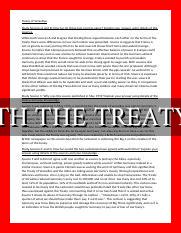-
Table of Contents
3 Problems with the Treaty of Versailles
Introduction
The Treaty of Versailles, signed in 1919 at the end of World War I, was intended to bring peace and stability to Europe. However, the treaty had several flaws that ultimately contributed to the outbreak of World War II.
. In this article, we will explore three key problems with the Treaty of Versailles and their implications.
1. Harsh Reparations
One of the major issues with the Treaty of Versailles was the imposition of harsh reparations on Germany. The treaty required Germany to pay massive sums of money to the Allied powers as compensation for the damages caused during the war. The reparations were so severe that they crippled the German economy and led to widespread poverty and unrest.
- Germany was required to pay 132 billion gold marks, a sum that was impossible for the country to repay.
- The economic hardship caused by the reparations fueled resentment among the German population and created a fertile ground for extremist ideologies like Nazism to take hold.
The harsh reparations imposed by the Treaty of Versailles not only destabilized Germany but also contributed to the economic turmoil that plagued Europe in the interwar period.
2. Loss of Territory
Another significant problem with the Treaty of Versailles was the loss of territory suffered by Germany and other defeated nations. The treaty redrew the map of Europe, stripping Germany of significant portions of its territory and population.
- Germany lost Alsace-Lorraine to France, West Prussia and Posen to Poland, and the Saar Basin to the League of Nations.
- The loss of territory not only weakened Germany but also created ethnic tensions in the newly formed states, leading to conflicts and instability in the region.
The territorial changes imposed by the Treaty of Versailles sowed the seeds of future conflicts and contributed to the rise of nationalist sentiments in Europe.
3. Failure to Address Root Causes
One of the fundamental problems with the Treaty of Versailles was its failure to address the root causes of World War I. The treaty focused on punishing Germany without addressing the underlying political, economic, and social issues that had led to the war in the first place.
- The treaty did not establish a lasting peace settlement or create mechanisms to prevent future conflicts.
- It did not address the grievances of all parties involved in the war, leading to simmering resentment and unresolved tensions.
By failing to address the root causes of the war, the Treaty of Versailles set the stage for future conflicts and ultimately proved to be ineffective in maintaining peace in Europe.
Conclusion
In conclusion, the Treaty of Versailles had several significant problems that ultimately contributed to the outbreak of World War II. The harsh reparations, loss of territory, and failure to address root causes all played a role in destabilizing Europe and creating conditions for future conflicts. It is essential to learn from the mistakes of the past and strive for more equitable and sustainable peace settlements in the future.
For further reading on the topic, you can visit History.com.





